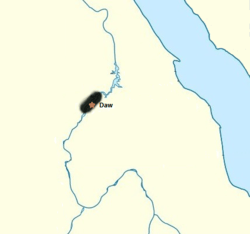Dotawo
| Kingdom of Dotawo | |||||
| |||||
 Minimum extension of Dotawo | |||||
| Capital | Daw (city) | ||||
| Languages | Old Nubian | ||||
| Religion | Coptic Christianity | ||||
| Government | Monarchy | ||||
| History | |||||
| • | Established | Disputed | |||
| • | Disestablished | Late 15th/Early 16th century | |||
Dotawo (Old Nubian: Lower Dau or Daw) was a kingdom that might have existed in the Beja Region of Lower Nubia (Northern Sudan and Southern Egypt) in the Middle Ages. It has long been known that a kingdom by this name is mentioned as existing during the collapse of the Kingdom of Makuria in the thirteenth century. It was reported to be one of the last surviving Christian states in the region.
History
Scholars believed it was one of a number of small successor states to emerge during this anarchic period. However, the large collection of documents found at Qasr Ibrim in the 1960s overturned this view. The Qasr Ibrim find contains many documents relating to relations between the Eparch of Nobatia and the King of Dotawo. These include relations during Makuria's peak in the 12th century. The Eparch even seems to have had far more dealings with the king of Dotawo than his overlord the king of Makuria.
One explanation for this is that Dotawo is simply another name for Makuria. The depiction of multiple kings clashes with the description of the region given by Arab traveler Ibn Selim el-Aswani. In no known document are the names of both Dotawa and Makuria present, and at several points the listed names of the king of Dotawa matches those of Makuria.
However at many other points in time the name of the King of Dotawa being written to does not match that of the King of Makuria. The name also seems to indicate a Kingdom based at Gebel Adda, also known as Daw. One Arab writer reports that the Beja region was structured with thirteen lesser kings under one "Great King," and Dotawo could have been one of these vassal kingdoms.
References
- Adams, William Y. "The United Kingdom of Makouria and Nobadia: A Medieval Nubian Anomaly." Egypt and Africa: Nubia from Prehistory to Islam. Edited by W.V. Davies. London: British Museum Press, 1991.
Coordinates: 22°17′50″N 31°38′13″E / 22.29722°N 31.63694°E